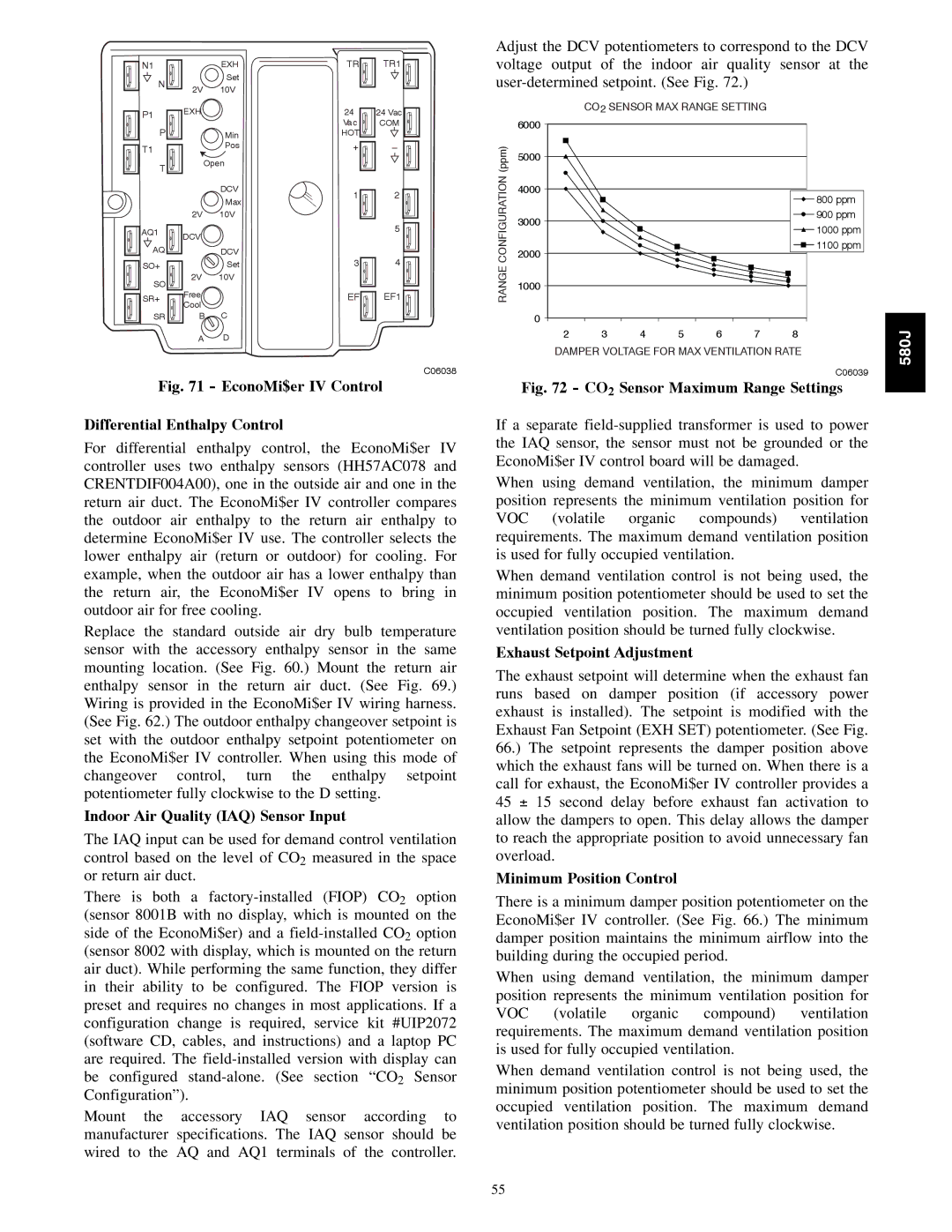Safety Considerations
Table of Contents
General
Unit Arrangement and Access
What to do if you smell gas
Seasonal Maintenance
Routine Maintenance
Supply Fan Belt-Drive
Supply FAN Blower Section
Manual Outside Air Hood Screen
Supply-Fan Pulley Adjustment Bearings
Adjustable-Pitch Pulley on Motor
Evaporator Coil
Coil Maintenance and Cleaning Recommendation
Cooling
Condenser Coil
Routine Cleaning of Evaporator Coil Surfaces
Routine Cleaning of Novation Condenser Coil Surfaces
Refrigerant Charge
Refrigerant System Pressure Access Ports
Puronr R-410A Refrigerant
Evaporator Coil Metering Devices
Seatcore
Cooling Charging Charts 08D,F Both Circuits
Cooling Charging Charts
Cooling Charging Charts 12D,F Both Circuits
TON Circuit
TON Circuit
Problem Cause Remedy
Cooling Service Analysis
Compressors
Condenser-Fan Adjustment 08D-12D,F size
Condenser-Fan Adjustment 14D,F size
Troubleshooting Cooling System
Convenience Outlets
Installing Weatherproof Cover
Non-Powered Type
Unit-Powered Type
Smoke Detectors
Smoke Detector Locations
Sensor
Supply Air
All Units
Completing Installation of Return Air Smoke Sensor
Fiop Smoke Detector Wiring and Response
Return Air Without Economizer
Sensor and Controller Tests
Dirty Sensor Test Procedure
Controller Alarm Test
Controller Alarm Test Procedure
Dirty Controller Test Procedure
Dirty Sensor Test Using an SD-TRK4
Detector Cleaning
SD-TRK4 Remote Alarm Test Procedure
Remote Test/Reset Station Dirty Sensor Test
Troubleshooting
Compressor Protection
Protective Devices
Control Circuit
GAS Heating System
Fuel Types and Pressures
Liquid Propane Supply Line Pressure Ranges
Supply Pressure Switch
Flue Gas Passageways
Combustion-Air Blower
Main Burners
Burners and Igniters
Orifice Projection
Check Unit Operation and Make Necessary Adjustments
Cleaning and Adjustment
Limit Switch
LED Indication Error Code Description
LED Error Code Description
Burner Ignition
Gas Valve
Orifice Replacement
Red LED-Status
Altitude Compensation
Orifice Sizes
LP Orifice
Minimum Heating Entering Air Temperature
Troubleshooting Heating System
Heating Service Analysis
IGC
IGC Board LED Alarm Codes
Replacing Novation Condenser Coil
Condenser Coil Service
Repairing Novation Condenser Tube Leaks
RTU-MP Control System
RTU-MP Multi-Protocol Control Board
Typical RTU-MP System Control Wiring Diagram
Outputs
Supply Air Temperature SAT Sensor
Outdoor Air Temperature OAT Sensor
RTU-MP Controller Inputs and Outputs
EconoMi$er
Space Temperature SPT Sensors
Connect T-55
Outdoor Air Enthalpy Control PNO HH57AC077
Economizer Controls
Indoor Air Quality CO2 Sensor
Wiring the Indoor Air Quality Sensor
Differential Enthalpy Control
Return Air Enthalpy Sensor
Filter Status
Connecting Discrete Inputs
Outdoor Air Quality Sensor PNO 33ZCSENCO2 plus
Weatherproof Enclosure
Communication Wiring Protocols
Power Exhaust output
Baud Rate DS2 DS1
RTU-MP Troubleshooting
Communication LEDs
Protocol DS8 DS7 DS6 DS5 DS4 DS3 DS2 DS1
LEDs on the RTU-MP show the status of certain functions
LEDs
Troubleshooting Alarms
BACnet MS/TP
Alarms
Module Status Report Modstat Example
Code Name Meaning
Basic Protocol Troubleshooting
Modbus
Manufacture Date
EconoMi$er IV Component Locations
ECONOMI$ER Systems
EconoMi$er IV Wiring
EconoMi$er IV Functional View
EconoMi$er IV Input/Output Logic
Outdoor Dry Bulb Changeover
Supply Air Temperature SAT Sensor
Outdoor Air Lockout Sensor
EconoMi$er IV Control Modes
Outdoor Enthalpy Changeover
Differential Dry Bulb Control
Indoor Air Quality IAQ Sensor Input
Exhaust Setpoint Adjustment
Minimum Position Control
Thermostats
Damper Movement
Demand Control Ventilation DCV
CO2 Sensor Standard Settings
CO2 Sensor Configuration
Analog CO2
Differential Enthalpy
DCV Demand Controlled Ventilation and Power Exhaust
EconoMi$er IV Sensor Usage
EconoMi$er IV Preparation
Supply-Air Sensor Input
Wiring Diagrams
EconoMi$er IV Troubleshooting Completion
DCV Minimum and Maximum Position
580J Typical Unit Wiring Diagram Power 08D,F, 208/230-3-60
C09157
Gas Piping
PRE-START-UP
START-UP, General
Unit Preparation
Outdoor-Air Inlet Screens
Internal Wiring
Refrigerant Service Ports
Return-Air Filters
START-UP, RTU-MP Control
Field Service Test
Configuration
Unit Start Delay
Compressor2 Service Hours
Filter Service Hours
Supply Fan Service Hours
Compressor1 Service Hours
Input 2 Function
Input
Space Sensor Type
Input 1 Function
Cooling, Unit With EconoMi$er
Operating Sequences
Base Unit Controls Cooling, Units Without Economizer
Heating, Units Without Economizer
RTU-MP Sequence of Operation
Heating With EconoMi$er
Demand Controlled Ventilation
Supplemental Controls
BACnet Schedule
Always Occupied Default Occupancy
Scheduling
Local Schedule
Cooling
Power Exhaust
Economizer
Torque Values
Fastener Torque Values
Indoor Air Quality
Demand Limit
Position Number
Appendix I. Model Number Significance
Model Number Nomenclature
Serial Number Format
Physical Data
Appendix II. Physical Data
12.5TONS
Natural Gas Heat, Liquid Propane Heat
Heat Anticipator Setting Amps
Physical Data Heating 12.5TONS
580J**08 580J**12 580J**14 Gas Connection
580J**08
Appendix III. FAN Performance
CFM RPM BHP
579
580J**12
RPM BHP
580J**14
1260
General fan performance notes
Unit MOTOR/DRIVE Motor Pulley Turns Open Combo
Pulley Adjustment
Electrical Information
Mocp
Unit Combustion Power
NOM IFM FAN Motor Exhaust No P.E
Type DISC. Size
Wiring Diagrams
Appendix IV. Wiring Diagram List
Catalog No.SM580J---02
Appendix V. Motormaster Sensor Locations
580J
Preliminary Information
Unit START-UP Checklist

